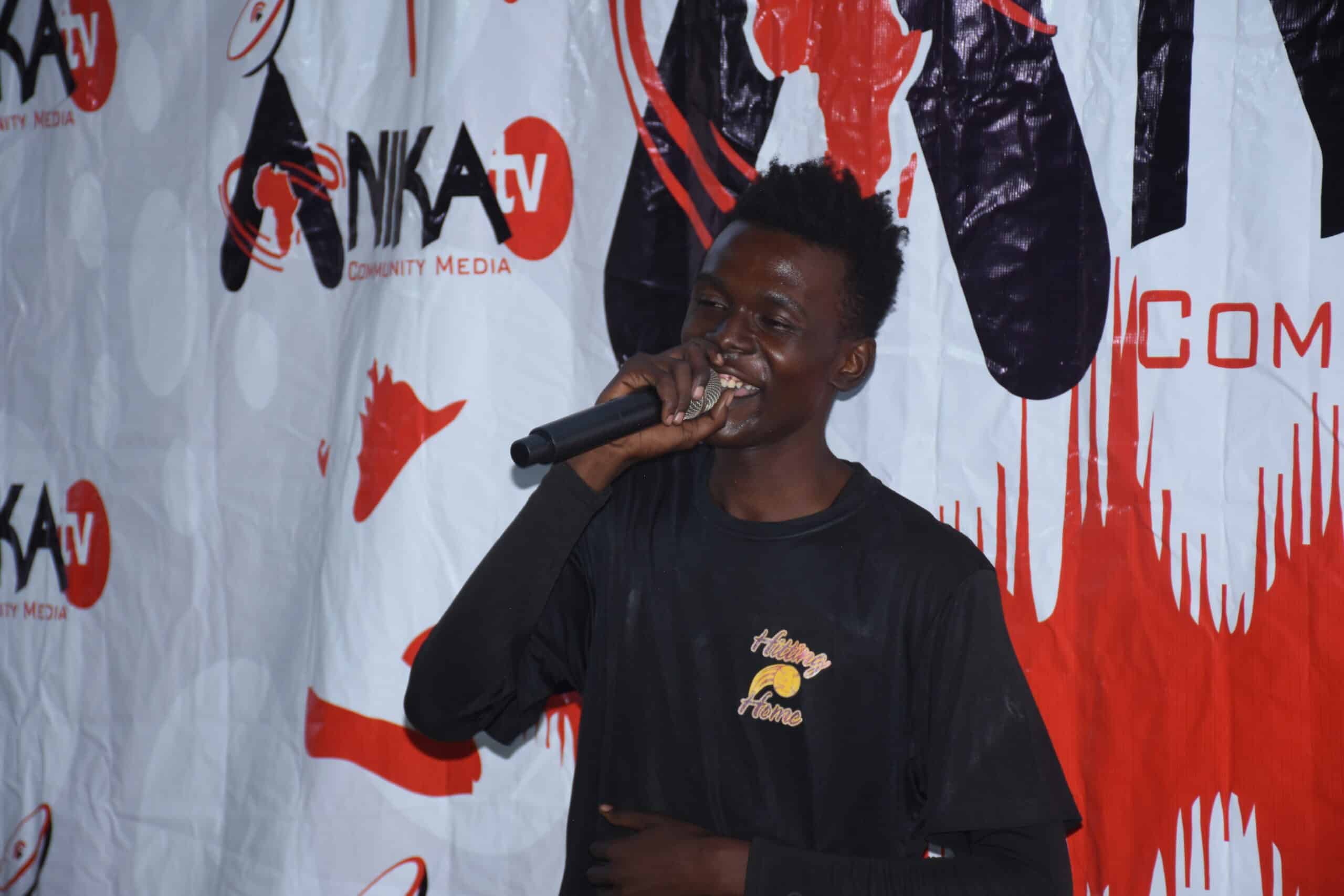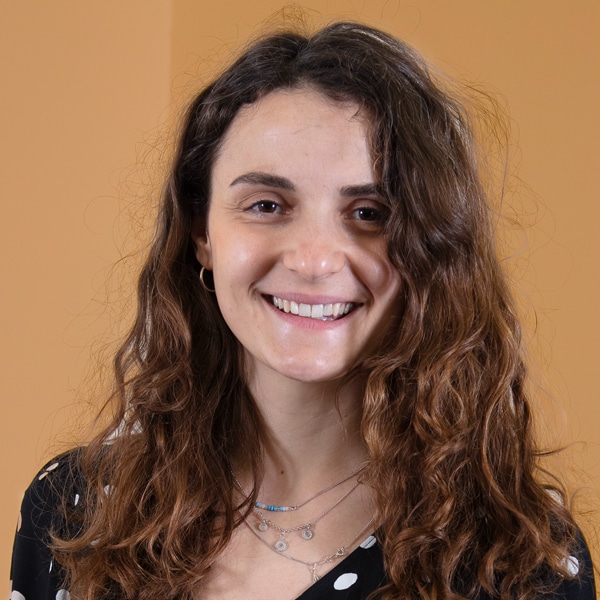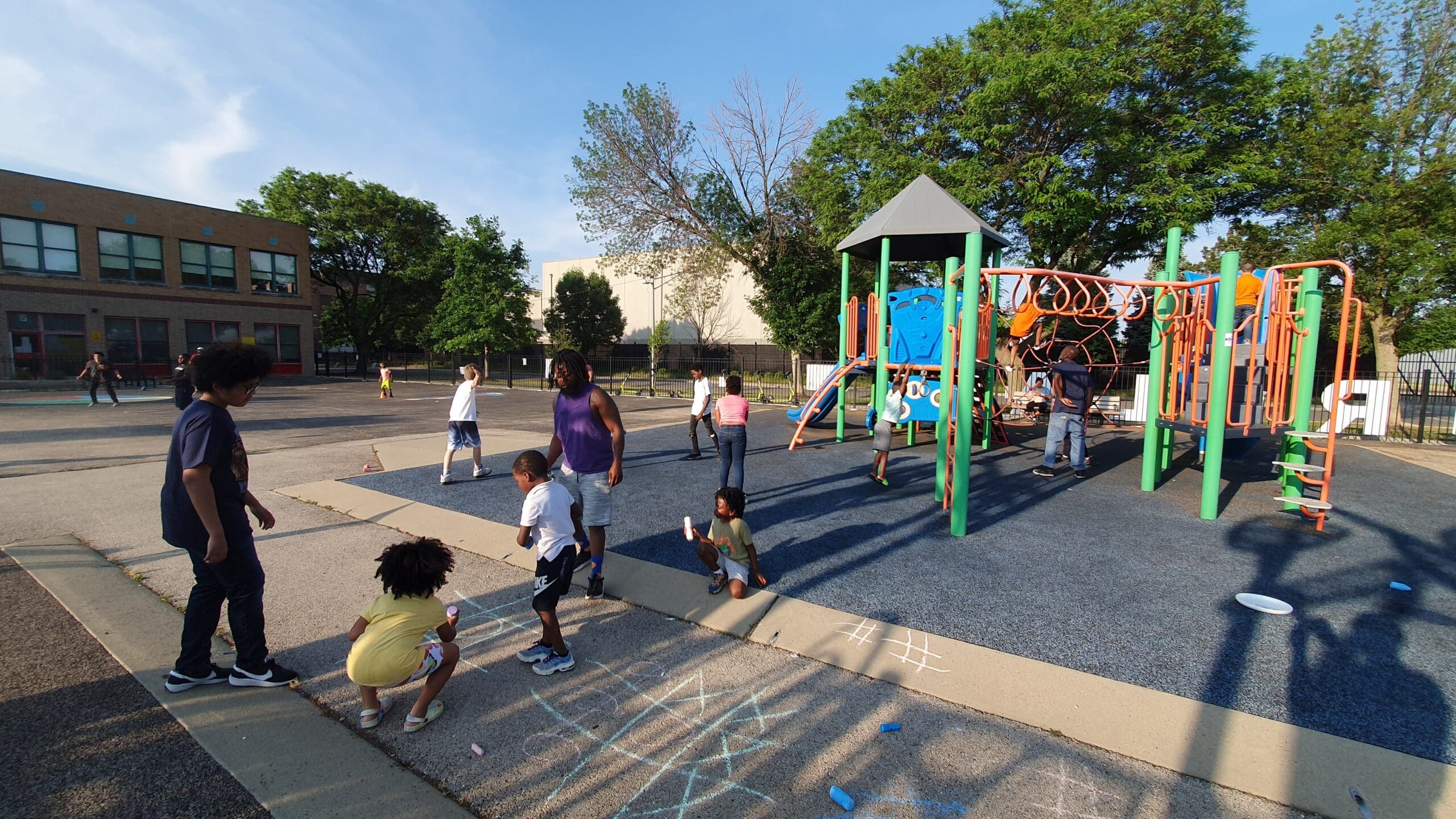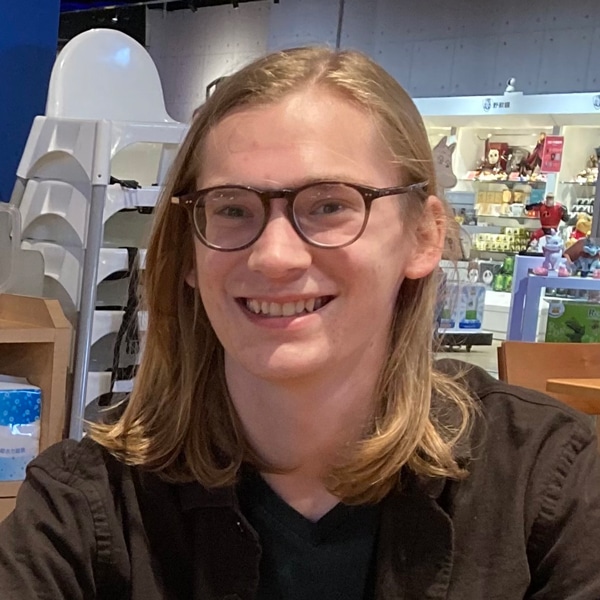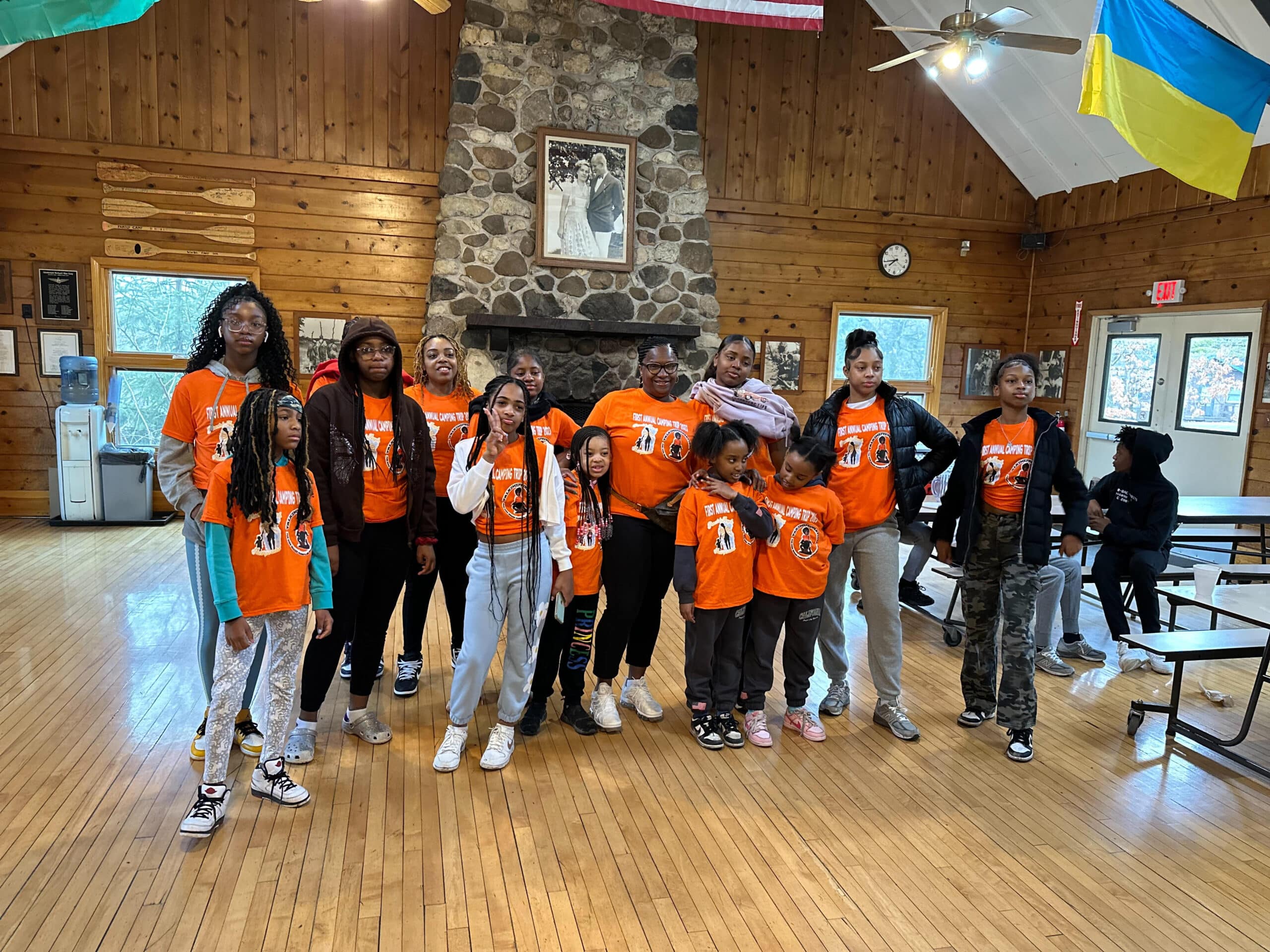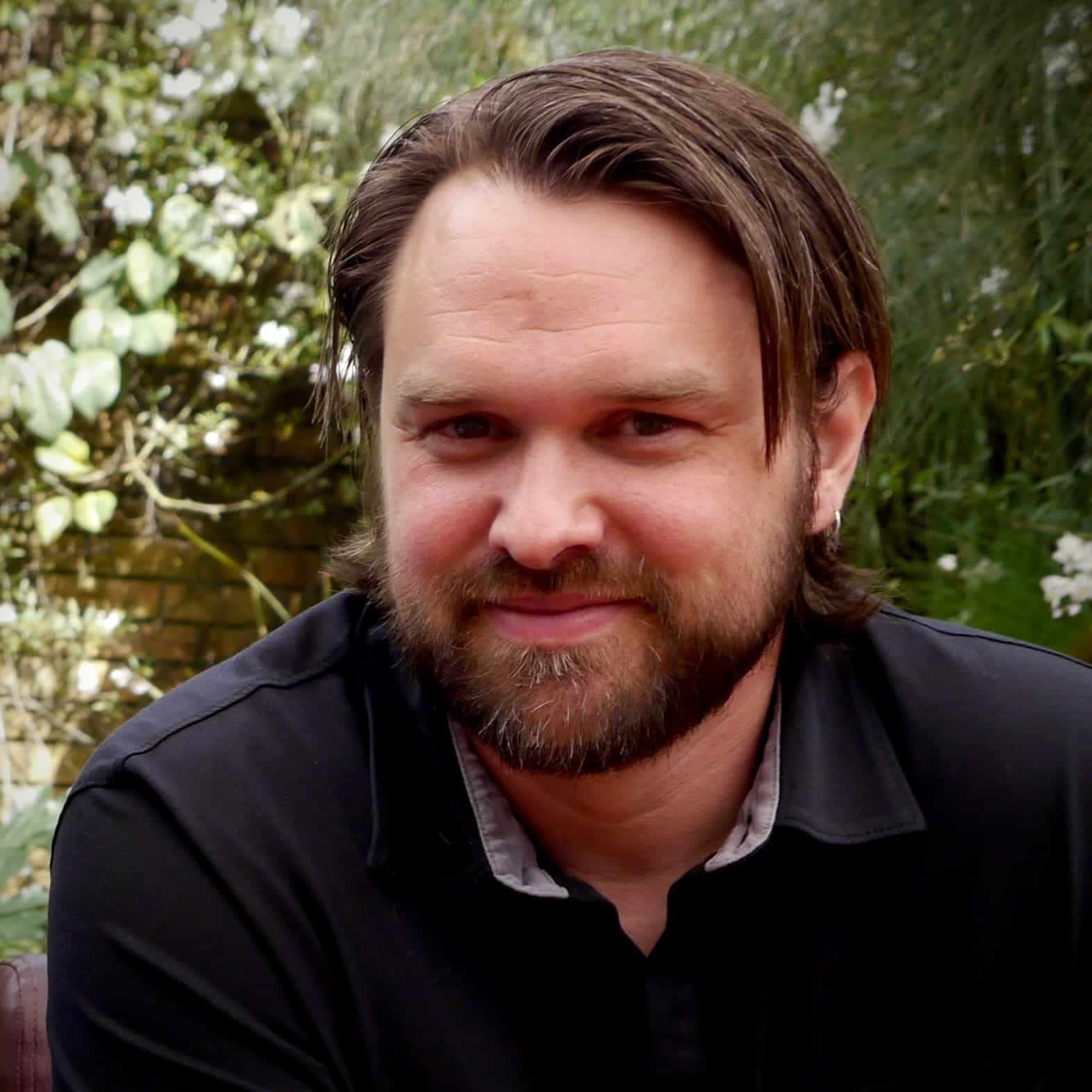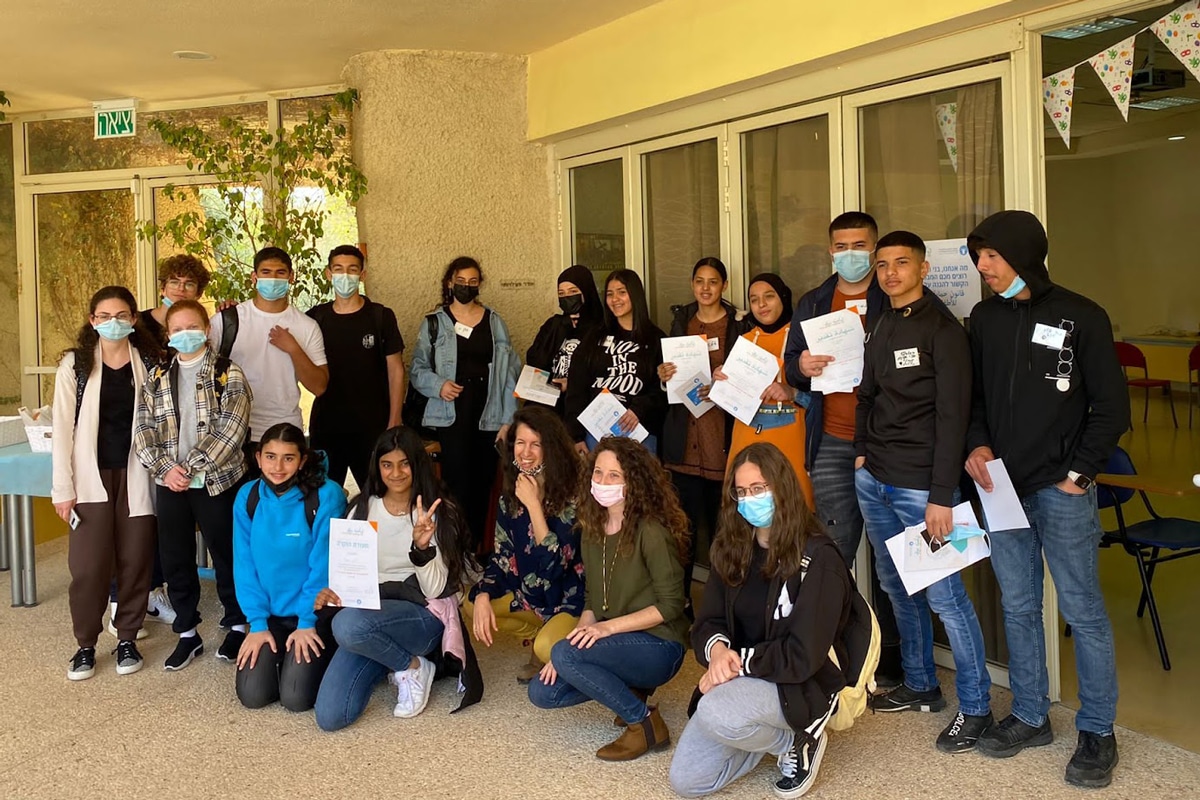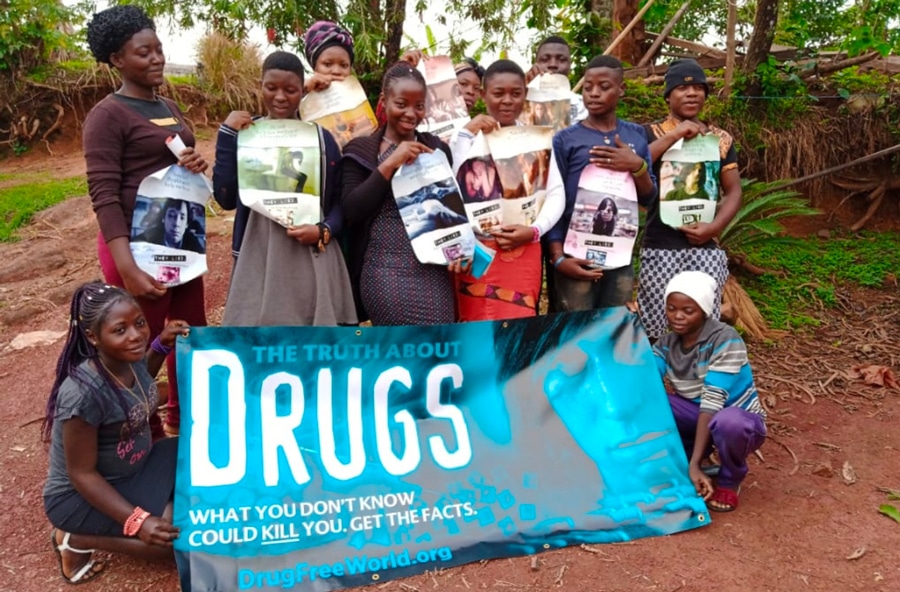Anika Talent Show: Empowering Kenya's Youth for Environmental Education
Visual artists, dancers, poets, thespians, and vocalists between the ages of 14 and 25 were brought together in a lively event in Kenya promoting green skills and environmental justice, aligning with the International Youth Day 2023 theme.
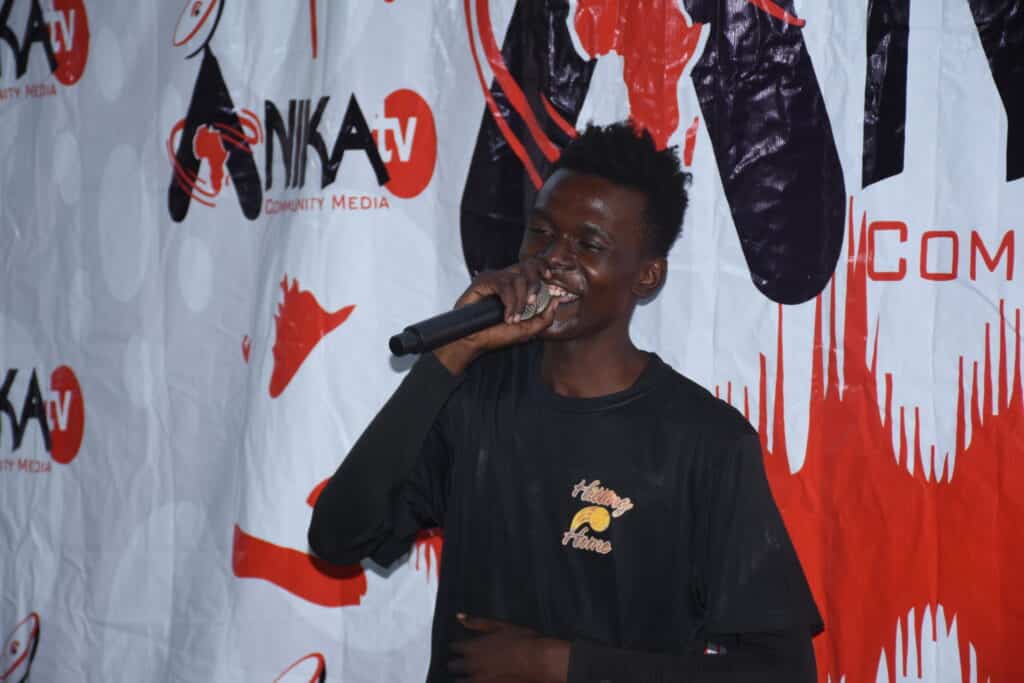
This event was made possible by Nicholas Songora, 2021 Goldin Global Fellow from Kenya and Founding Director Manyatta Youth Entertainment, and his dedicated team behind organizing the Anika Talent Show in celebrating International Youth Day in Partnership with the Forum civ Eastern and Southern Africa hub under the Wajibu Wetu; Jumuika Sikika Program with collaboration from the private sector, religious leaders, persons with disabilities leadership, national and county governments.
Nicholas speaks more to the Goldin Institute about this activity and why it represents a movement that harnesses the power of art to drive change.
He believes that people together can create a sustainable world where everyone, through artivism, contributes to a brighter future. Already, he is leaving his mark on infusing positive change and possibilities among young people.
Nurturing the Youth as Change Agents for Environmental Issues
This gathering equipped young people with green skills and a profound understanding of environmental justice while utilizing the transformative potential of arts to foster sustainability in society.
Nicholas delves into how they incorporated sustainability and environmental justice in this event.
“The activity involved performances like dance and music that narrated stories of environmental struggles, resilience, and hope. These performances fostered empathy, understanding, and a sense of responsibility toward the planet. This was a powerful medium to raise awareness about environmental challenges.” - Nicholas Songora

He highlights that photographers pledged to vividly portray environmental issues, ecological beauty, and the consequences of unsustainable practices through art exhibitions.
From the interactive discussion, participants, including village elders, engaged in addressing climate change challenges. They shared personal experiences and ideas for climate action, including sustainable agriculture, waste management, and energy conservation.
Strengthening Community Work through Networking
Further, he expresses his gratitude to several collaborative partners who contributed to the success of the Anika Talent Show.
“As an organization, we prioritize a multi-sectorial approach in programs and project management. According to our strategic focus, one of our critical mandates is to create linkages and alliances with other like-minded organizations and institutions.”
Therefore, Nicholas adds building partnerships and collaborations places the organization at the center of decision-making tables at the county, regional, and national levels.
“This has fostered community ownership and has enhanced sustainability. We collaborate closely with the national and county governments, the private sector, and religious institutions. Also, we collaborate with youth, women, and persons with disabilities networks while forming part of the civil society leadership in Kenya's Coastal region.”
He sees collaboration as fostering cost efficiency and effectiveness, sustainability, and long-term impact accepted by the masses.
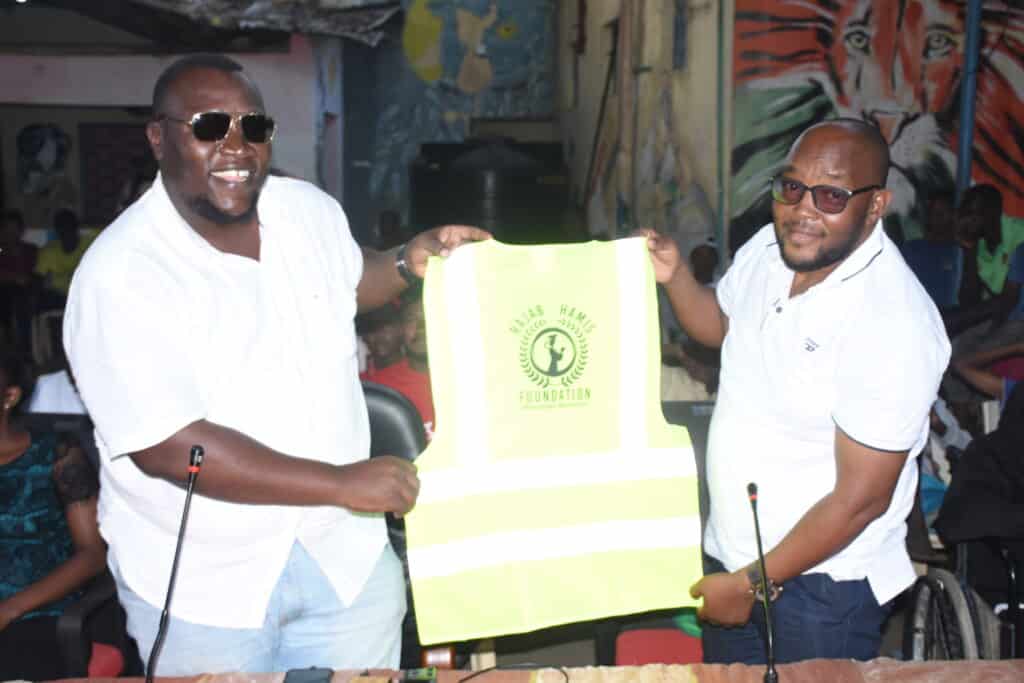
The Lasting Impact of the Goldin Institute Fellowship and Looking Forward
Nicholas acknowledges that he applied the key strategies learned from the Goldin Global Fellowship, from planning to executing the Anika Talent Show.
“Through design, we applied the concept of community asset mapping, which we learned during the Goldin Global Fellowship. In this step, we reflected on the available stakeholders at the grassroots and national levels.”
Further, he elaborates on how they divided into mapping the available resources and funding to support the initiative.
“Identifying potential collaborators was easy, including nominating young people to lead in the activity. Mapping of potential artists within the Anika Community Hub and inviting more from the community.”
Conclusively, drawing from his experience, Nicholas shares his advice with aspiring young people and how they can play a proactive role in their communities.
“The #YouthTribe is a powerful family with all it takes to change the existing narrative and achieve a green economy as a global identity.” he says.
“In most countries, youth form the largest percentage of the population; for example, in my country, Kenya, we are approximately 80% of the population but cannot make a difference if we keep working in isolation. We must unify our voices, be counted, and influence our way to the decision-making table through dialogue and collaboration.”
He draws our attention to the fact that youth cannot win by competing or fighting other stakeholders but by embracing the unity of purpose and fostering collaboration.
Nicholas calls youth to “rise and start building partnerships and networks with multi-stakeholders.”
How the Island is Reactivating Their Public Spaces
This summer, the Island Civic Association worked with young people in the Island neighborhood of Austin to reactivate a playlot owned by G. R. Clark Elementary School as a public space. Nate Tubbs, a 2023 Chicago Peace Fellow and president of the Island Civic Association (ICA), was heavily involved in organizing the project. The work of Nate and the ICA aims to create a more connected, inclusive, and thriving community in the Island. In an effort to activate gathering spaces, ICA has been working with G. R. Clark and young community members to host Playlot Nights at the G. R. Clark Playlot. These events aim to attract attention towards creating more public outdoor spaces and promoting a healthier and more cohesive neighborhood.
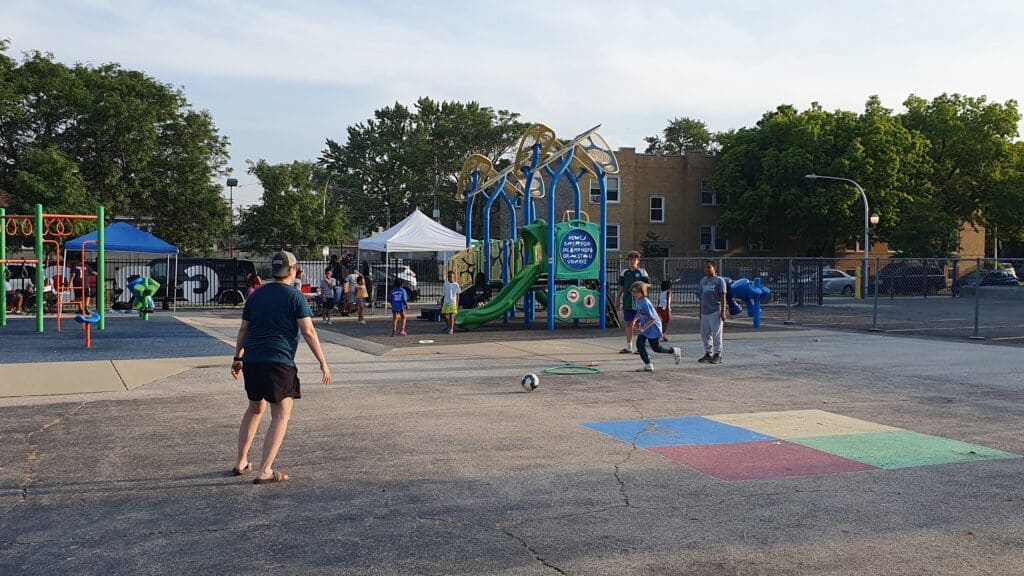
The playlot provides a large open space for people of all ages to utilize.
The Need for Public Space
Currently, the Island lacks outdoor spaces for young people and families to gather. The ICA has identified this as a problem that often causes people to have to leave the neighborhood for recreation. Nate comments, “The Island is a small pocket of the Southwest Austin community. It is a great little area, but it is kind of land-locked. This means a lot of people have to leave the neighborhood to go to a park or playground.” One way the ICA has worked to solve this problem is by activating existing areas to serve as public spaces in addition to their current uses.

Playlot Nights provided an opportunity for people to gather in a public space that was previously closed outside of school hours.
In the past, the neighbors within the Island community have worked together to activate vacant spaces through community partnerships, however the Playlot project seeks to activate existing space on a larger scale through partnership with G. R. Clark. Island residents previously created a Nature Play Garden as an intergenerational outdoor space on a vacant city lot. However, the ICA’s work on the G. R. Clark Playlot Project focuses on creating a larger space where community members can gather for larger events or play sports and is dependent on working cooperatively with G. R. Clark. Up until this point, the G.R. Clark playground has been regularly locked outside of school hours. Many community members have asked whether it can be opened more regularly. In response ICA has been in discussion with the school about how they can activate the space for community events.
The Playlot Project
To show community support for opening the playlot to the public, the ICA and the G. R. Clark Local School Council have invested in its renovation alongside young people and community partners. The 'Playlot Project' has aimed to center the voices of the young people who plan to use the space in discussions about the playlot’s future.
Improve Existing Facilities
Students provided their ideas for improving the playlot and one of their primary concerns was to renovate a fence outside of the school that had become an eyesore. Community members and students worked together to install garden beds, repaint the fence, and add new plants and benches. Their work was aided by partnering with the humanitarian organization Convoy of Hope, as well as John Burns Construction and Christy Webber Landscaping Company which both provided employee volunteers to help improve the space. This spring, students added new signage and lettering to the fence along the playlot. These efforts to beautify the space, showed ownership, and demonstrated that there are people who care and are working on the space.
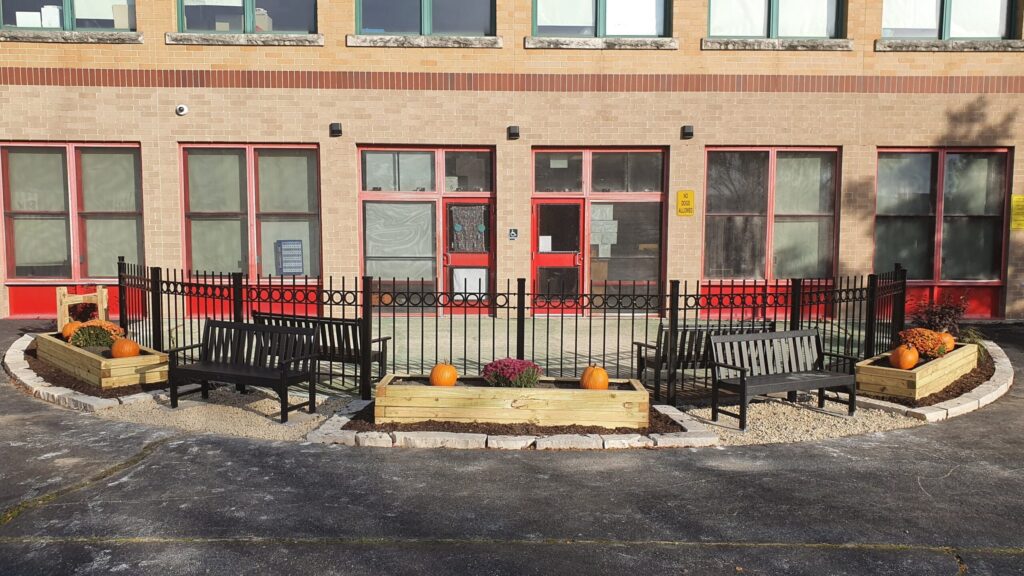
Increase Access
Following the renovations, the Playlot Nights acted as a proof of concept that the community is invested in reactivating the space. Playlot Nights were held on first Fridays through the summer, in June, July, and August when kids of all ages came together to play. The events incorporated activities for all ages such as chalk drawing, kickball games, music, and cold drinks. Nate noted that each night attracted new crowds. “I think that’s the beauty of doing something outdoors. While some people came from getting flyers and emails, other people were just walking their dogs or riding their bikes and stopped by. Some people drove by and did a double take because they weren’t used to seeing people using the space. So it was really a positive thing with great energy.”
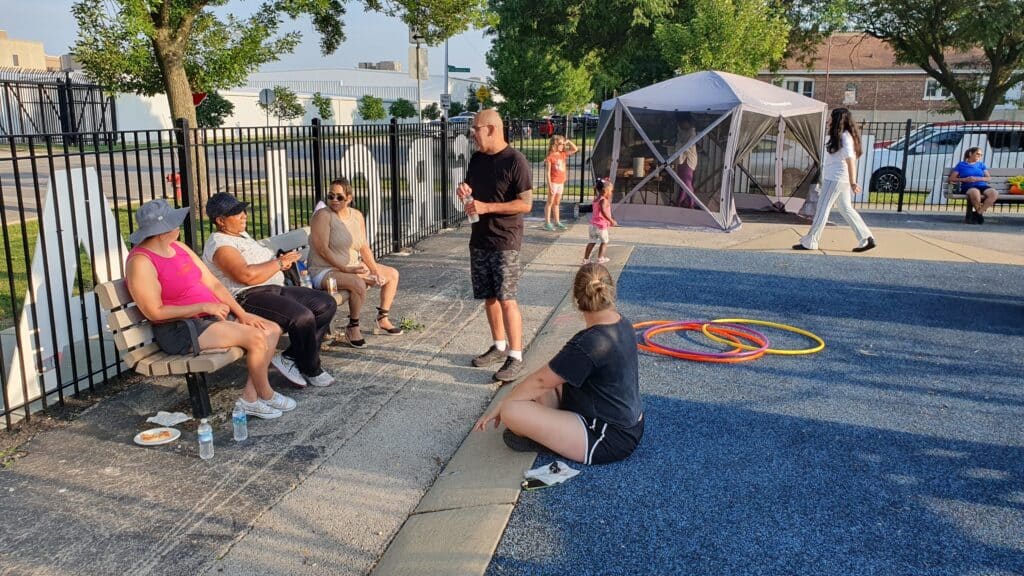
The input of young people is central to the community’s plans for the future of the Playlot project. Six young community members between the ages of 12 and 15 were commissioned by the ICA as Youth Ambassadors and helped organize the Playlot nights. Each Youth Ambassador lives within the Island neighborhood and worked alongside the community to plan the Playlot Nights in exchange for stipends. Youth Ambassadors planned events, distributed flyers, and administered games and activities. By showing that young people are capable of taking action to plan the future of the playlot and administer programs, ICA hopes to generate more community involvement and incrementally work towards a larger scale transformation of the space.
"The Playlot Nights brought the community together to have fun and opened the playlot to connect the community as a whole."
- Henry Ellis, ICA Youth Ambassador
The Playlot Project demonstrates the change that happens as a neighborhood explores their strengths. The Playlot is not something new to the Island neighborhood, but is an asset that is being reactivated through community involvement. Looking towards the future, the ICA aims to continue to maximize its impact in the community through collaboration and investment in existing resources.
Camp Duncan Brings Social Engagement and Smiles to Chicago’s Youth
The girl in this picture is Malia Causey, a nine-year-old from the Austin community in Chicago who lost her brother, Malik, to gun violence in 2016.

Her life has not been the same since the loss of Malik, who was 14 at the time of his death.
For Malia and other kids in similar situations, social activities and meaningful engagements with their peers are warmly welcomed.
"Ms. Davis, can we please ask the Goldin Institute and Talk2mefoundation to bring me back? This was really fun.''
Those are the words that Malia says to Nicole "Coco" Davis, 2021 Chicago Peace Fellow and CEO/President of Talk2mefoundation, who recently took young Chicagoans on a trip in the great outdoors at Camp Duncan.

"I like it here; no one will ever get shot or killed." Malia says further.
Malia's wishes lie in the heart of Talk2mefoundation. This non-profit organization supports kids whose parents and caregivers are incarcerated and need healing and peace through belonging to a community.
Speaking briefly to Goldin Institute about the importance of this youth camp, Nicole emphasizes the need for such support in the first place.
"They say money cannot buy you happiness, but the Goldin Institute brought 25 smiles for youths at Camp Duncan." -- Coco Davis
Thanks to the generous support of her peers in the Chicago Peace Fellows Mutual Aid Collaborative, she made it possible for these young people to socialize, learn, exercise, and dance together.
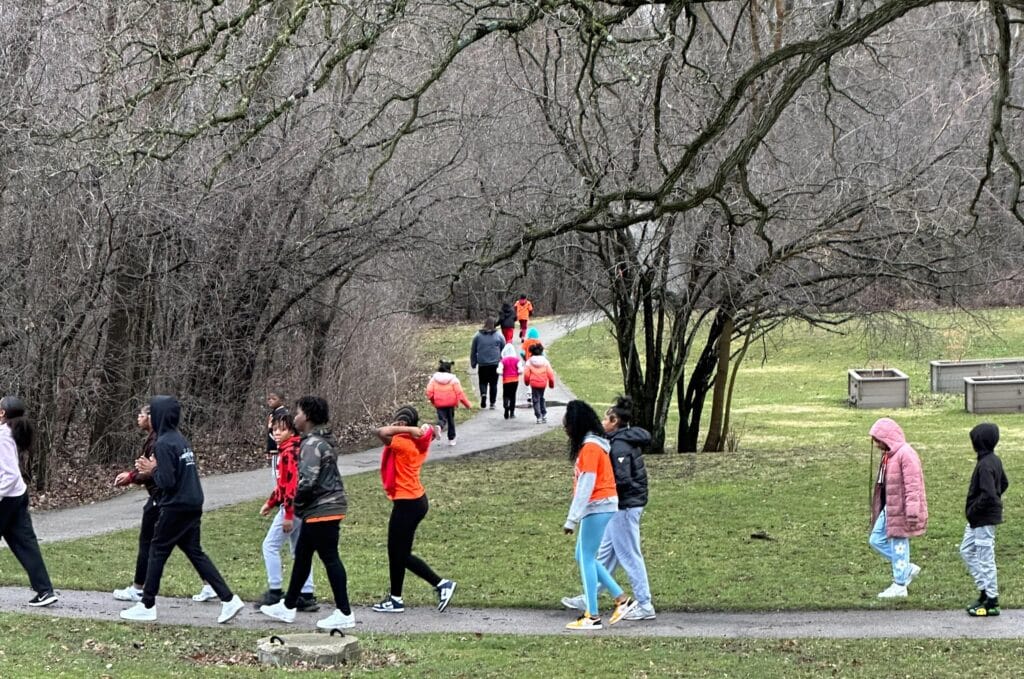
"Shout out to the Goldin Institute and the Mutual Aid Collaborative for making it possible for me to grant the wishes of 25 youths by giving them a chance to experience life outside of their normal living."
“I have so many sponsors to thank it's unreal" she wrote in this Instagram description, where you can also see the smiley faces of participants after a dancing challenge.
When becoming a Chicago Peace Fellow, Coco highlighted wanting to be part of the solution. She joined the Chicago Peace Fellows program to become a vital contributor to bringing healing and peace to communities in Chicago.
As one can see, Coco is an active voice and advocate for social justice; she keeps ties with with the Mutual Aid Collaborative made up of 74 Alumni of the Chicago Peace Fellows program as a valuable part of her community-driven approach to needed change. But the work continues beyond there.
Talk2mefoundation still needs support to continue its vital work in the community. Coco passionately advocates decriminalization and knows it takes a community to make a difference. That is why she's calling on everyone who believes in second chances and fundamental human rights to support her organization's work.
Every little bit counts, whether through a donation, volunteering, or simply spreading the word.
The connection between Goldin Institute and its fellows goes beyond the length of the program. When Fellows graduate from the Fellows Program they become part of the Mutual Aid Collaborative and the Global Alumni network that connects Chicago leaders like Coco with peers from over 40 countries across the globe.
Follow us to stay tuned for more opportunities:
Black Star Project Showcases Careers in Sports at the NBA All-Star Weekend
By: Zeki Salah, Communications Associate
The Black Star Project recently partnered with BDM Sports & Education Project to send Chicago students to Salt Lake City to learn about careers in sports at the NBA All-Star Weekend from February 17-19. This trip marked the third year that the Black Star Project has sent young people to the NBA All-Star Weekend to provide them with an inside look at the professional world of basketball and with a fun weekend of basketball events.
Brian McCoy, or Coach Q, began the BDM Sports & Education Project in 2014 with the goal of making a positive difference on the South Side after repeatedly hearing about violence on the news. “What I know is that a young person can’t shoot a gun and a ball at the same time. So I went to one of the roughest spots in Chicago and said, ‘Hey, I want to do a free sports camp for young kids’ [...] I think the kids I spoke to felt my sincerity because I gave them a clipboard and when I returned later the clipboard was filled on both sides.” Coach Q then went to his contacts in community activism and education, including Gloria Smith, a 2020 Chicago Peace Fellow, and approached them about starting a youth sports camp, with a focus on the business side of sports. He held his first camp in Englewood in 2014 and has continued to hold basketball camps, baseball camps, and most recently an introduction to golf.
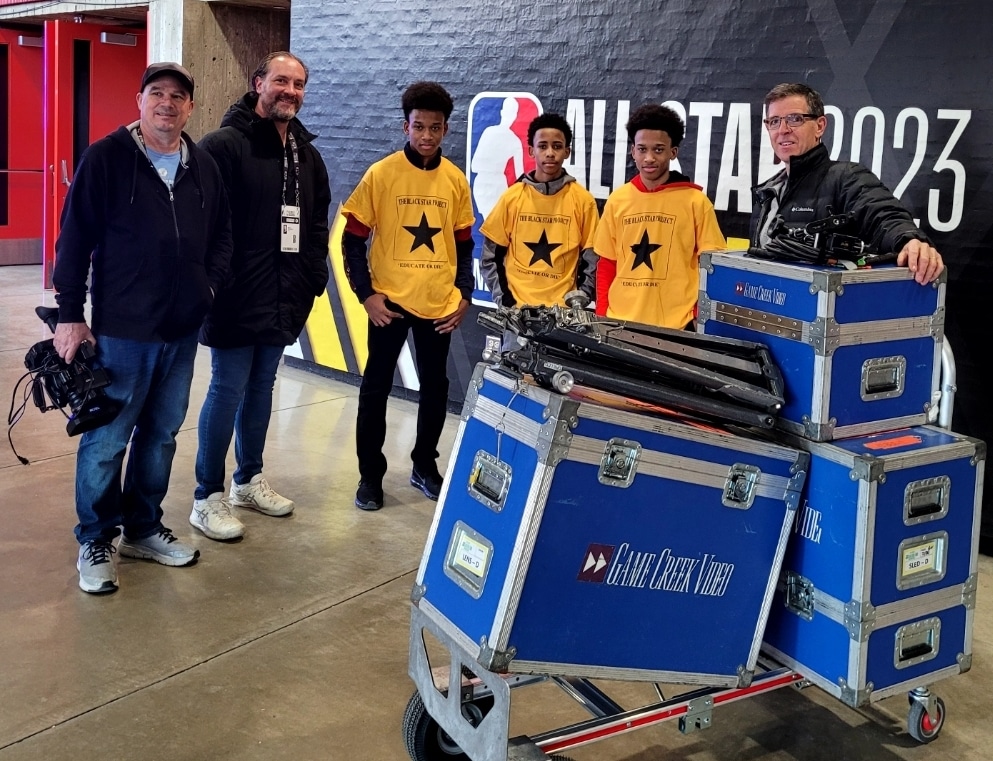
The trips to NBA All-Star Weekends have been held by Coach Q and the Black Star Project for the last three years. The trips aim to combine an introduction to the business of sports with a fun weekend for teens on the South Side. The trips place a focus on academics and include essay contests before and after the trip. In prior years, the Black Star project has chosen participants for the trips based on essays that they write on their interest in a career in sports. This year, an essay contest is being held for a cash prize following the trip. Coach Q and the Black Star Project also provide a ten week business of sports curriculum leading up to the trip, which allows the young people to learn about the different professions within the sports industry before they go on to meet them at events such as the All-Star Weekend. Speaking to the idea of synthesizing the business aspect and sports aspect of the trip, Coach Q said:
The average young person wants to be the next Lebron James, but in actuality, the probability is really slim [...] So, what I try to do is let them know that it’s okay to have dreams, but let them know the reality of the situation and ask: ‘What are you really looking for?’. By taking them to the game you can show them both sides, the excitement, but also the thousands of people making that game happen. There’s a camera man, a sports physician, a sports attorney, an agent, a sports statistician, a kinesiologist; there’s so many different careers involved that no one ever talks about.
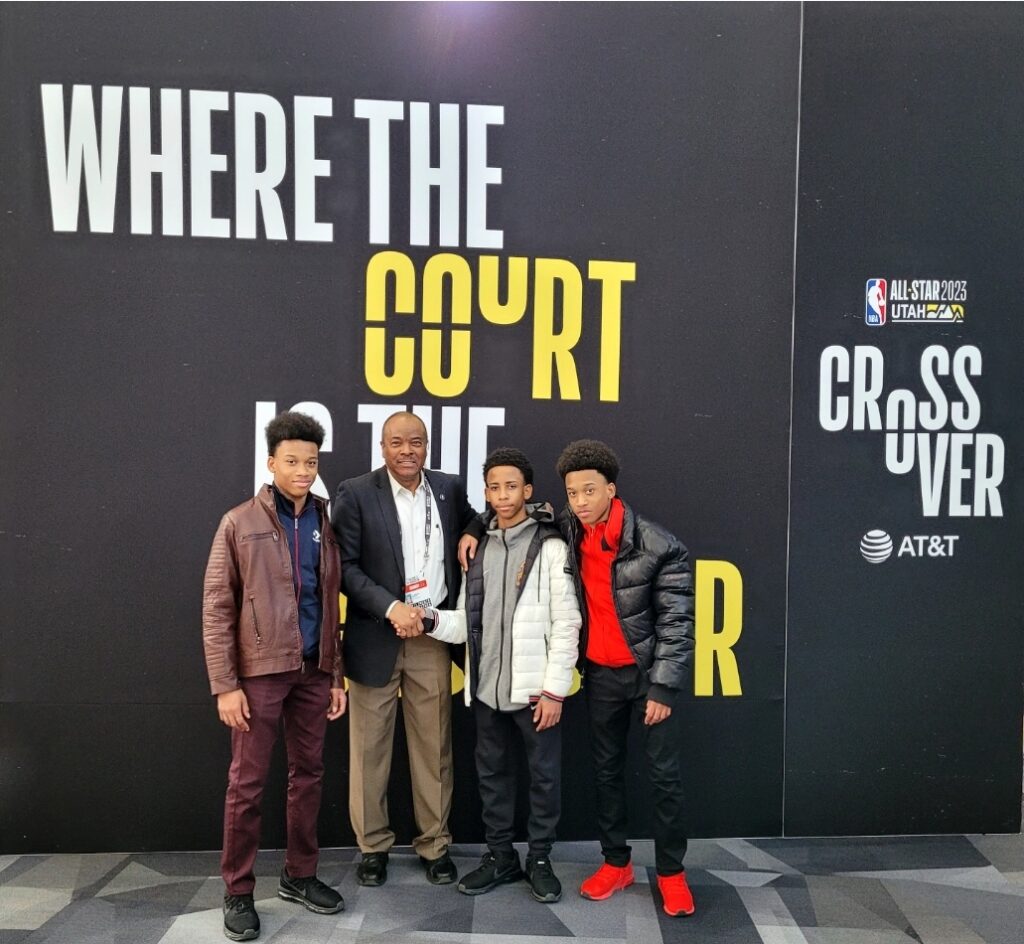
The Black Star Project took the lead on programming and fundraising for the All-Star weekend, while Coach Q accompanied the young people and introduced them to professionals in the sports business. The first event they attended was the HBCU Classic, an annual basketball game between two Historically Black Colleges and Universities (HBCUs) that was started by the NBA to show their commitment towards social justice in response to boycotts during the Black Lives Matter movement. The young people on the trip also participated in an HBCU college fair and learned about the NBA’s HBCU Fellowship program, which aims to provide career development opportunities in the business of basketball for undergraduate and graduate students from HBCUs. After the fair, the young people were also able to meet and greet with sports business professionals.
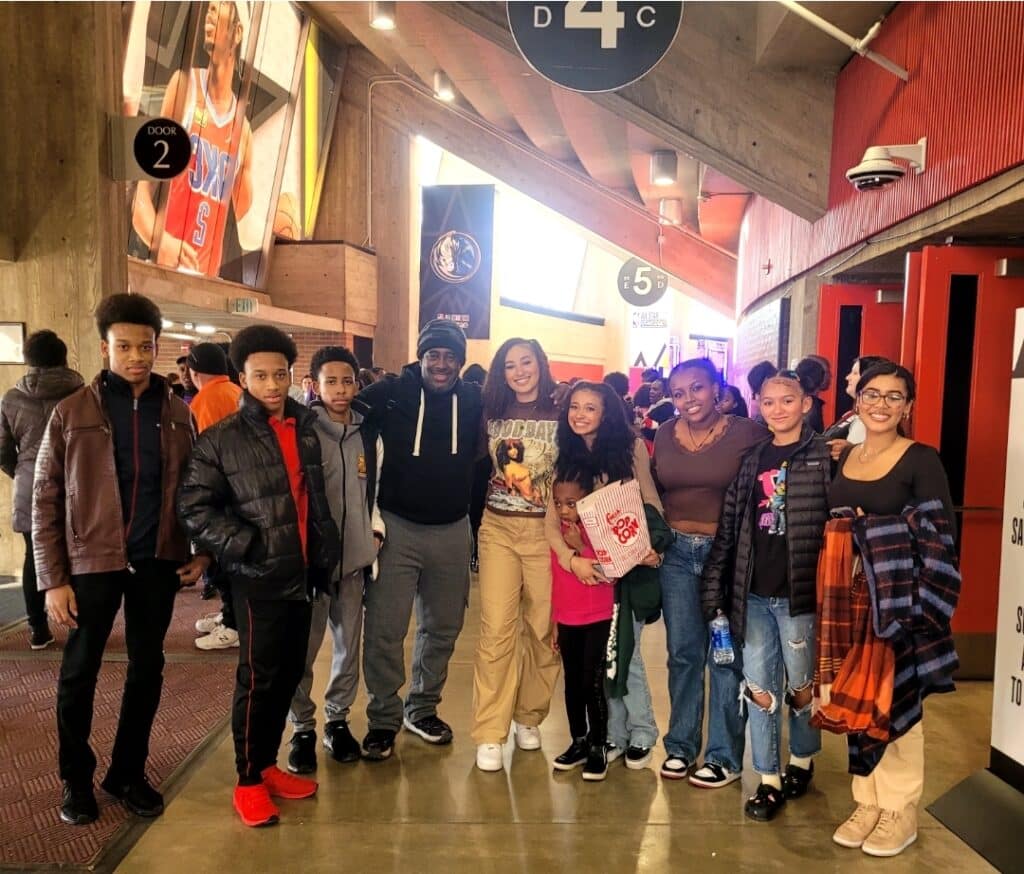
Throughout the weekend, programming combined both opportunities for the young people to have fun and enjoy basketball programming and an inside look into potential careers. The young people on the trip were able to have dinner with Rev. Jesse Jackson, who attended the University of Illinois on a football scholarship. He provided insight as to how entering the business of sports could allow an individual to transition to other careers, such as career as a minister and civil right leader. There was also a more leisurely section of the trip where the young people attended the NBA Crossover, which is a multi-day interactive fan event that brings basketball culture to the forefront, featuring player appearances, live performances, art, and music. Combining both business and pleasure helped the young people think about their futures in a fun and energetic setting and provided them with a one of a kind opportunity.
Coach Q and the Black Star project aim to continue to hold trips to NBA All-Star Weekends for young adults on the South Side. They hope to not only hold trips to the NBA All-Star games, but also to the WNBA All-Star games so that young women can get involved as well. The next WNBA All-Star game will be held in Las Vegas in July. You can support the Black Star Project and their efforts to send students to these games to learn about the business of sports here.
BDM Sports & Education Project's (Powered by the Black Star Project) 4th Annual Youth Business of Sports Essay Contest
Following the trip to Salt Lake City, BDM Sports and Education Project held an essay contest for high school students with the following prompt: "The average NBA playing career is about 5 years, how should players maximize their opportunities for personal growth and professional development, during their time playing in the league, while also preparing for when their NBA playing career comes to an end... Life Beyond the ball?"
Winners of the contest include:
1st Place Winner ($1,000): Brandon Williams-Orr, Providence St Mel HS
2nd Place Winner ($500): Aaron Williams-Orr, Providence St Mel HS
3rd Place Winners (Tied) ($250): Laylah Richmond, Bolingbrook HS and Antonio Scott, Little Black Pearl HS
A December To Remember: Mutual Aid Collaborative Organizes a Toy Drive
By Michael Henderson, Director, Mutual Aid Collaborative
Juliet Jones, a 2021 Chicago Peace Fellow Alumni and the Co-Founder and Director of The Original Sixty Fourth Street Drummers, Inc. “wanted to bring children back to play” due to the set back and effects COVID-19 had on kids during the holidays. She thought holding a toy drive to benefit children in under-served communities would be a good way of accomplishing this goal.
Juliet, passionate about making a difference for children, proposed The Universal Toy Drive to the Chicago Peace Fellows Mutual Aid Collaborative. The Mutual Aid Collaborative consists of 60 Black and Brown leaders and committed allies who live and work in the communities they serve on the South and West sides. They have raised over $100,000 to support several active projects, including The Universal Toy Drive.
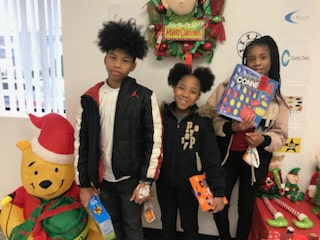
Juliet organized the Universal Toy Drive along with Dr. White, the TEECH Foundation, Clarity Clinic and Bethany Union Church to bring toys to disadvantaged children on the Southside of Chicago. Members from The Mutual Aid Collaborative, including Cosette Nazon-Wilburn of the LUV Institute, Jamila Trimuel of Ladies of Virtue, Gloria Smith of the Black Star Project, and Margaret Murphy-Webb of the Southside Jazz Coalition, all came together as a community to support Juliet. These leaders organized quickly by sharing flyers, sending and processing invitations, and reaching out to their network of parents.
On December 21, 2022, the Universal Toy Drive became a safe space for 113 children to play and receive gifts. The Universal Toy Drive was more than just giving toys away. Juliet knew the children who would be at the toy drive “normally missed out on a lot of things, not just toys, toys were the medium.” It was the intent of Juliet and the Mutual Aid Collaborative to bring joy to the lives of the under-served children and provide them with an opportunity to be kids.
Juliet was overwhelmed with joy as she got an opportunity to witness a village of children from a variety of places. Families who are dealing with HIV, children from the foster care system, children whose parents are incarcerated or in recovery, and other children from the community received all sorts of different toys, gift cards, coats, and other bags of goodies.

The 113 guests with their families that attended The Universal Toy Drive played board and video games, watched YouTube videos, played hopscotch and jump rope. They drank apple cider, hot chocolate, ate cookies and took pictures with Santa. The energy in the room was so amazing and filled with joy that the children received their gifts but, “didn't leave, they stayed and played, it was great”.
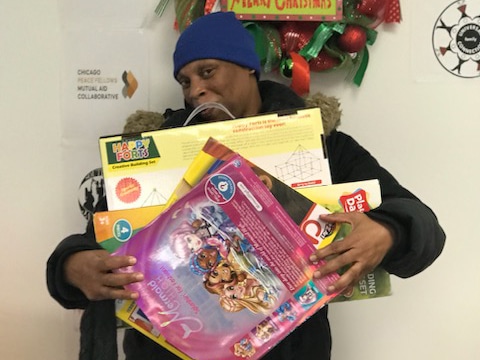
The collaborative efforts to touch the lives of children went beyond the imagination of Juliet’s and the village of local leaders. The Universal Toy Drive was a great success, providing 113 children with toys and gifting additional toys to The Universal Family Connection to use in their playroom for foster children. Juliet is ready for 2023 and has plans to continue to collaborate and organize with other community organizations to hold another Universal Toy Drive.
Generation Now Helps Teens Produce New Talk Show
By Zeki Salah, Facilitator, Mutual Aid Collaborative
The Chicago Peace Fellows Mutual Aid Collaborative is introducing teenagers to work in the media industry through a project called Generation NOW. Generation NOW was conceived by Messiah Equiano, a 2021 Chicago Peace Fellow, and aims to provide opportunities for young people to work on a teen talk show that addresses everyday issues that teenagers face. The program pays teenagers to produce, direct, and act in the show and provides them with a safe environment to express their thoughts.
Messiah originally thought of the idea of a teen talk show in 2014 and pitched the idea to the television station WCIU. The project was initially based on a show that appeared on BET in the 90s and early 2000s called Teen Summit. Teen Summit provided a platform for teenagers to talk about the everyday issues they face and brought these issues into perspective within an open and safe environment. Messiah thought the idea of a teen talk show was valuable and conceptualized Generation NOW as a similar program that would also allow the young people to get involved in aspects of production.
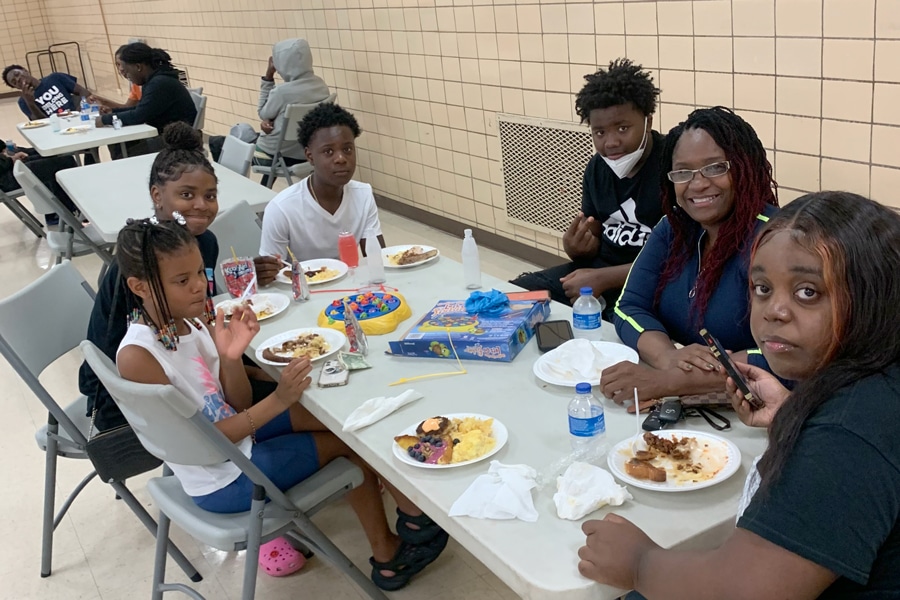
While the station turned down the pitch, Messiah persisted and applied for a grant from the Chicago Community trust to shoot a pilot episode of Generation NOW. He received the grant from the Chicago Community Trust in 2019 and filmed the pilot at Lawndale Community Academy. This experience showed him how therapeutic and empowering a platform for teens to express their issues could be. Since then, he has been working to secure funding to film more episodes of Generation NOW, including the August 5 filming that was funded by the Mutual Aid Collaborative.
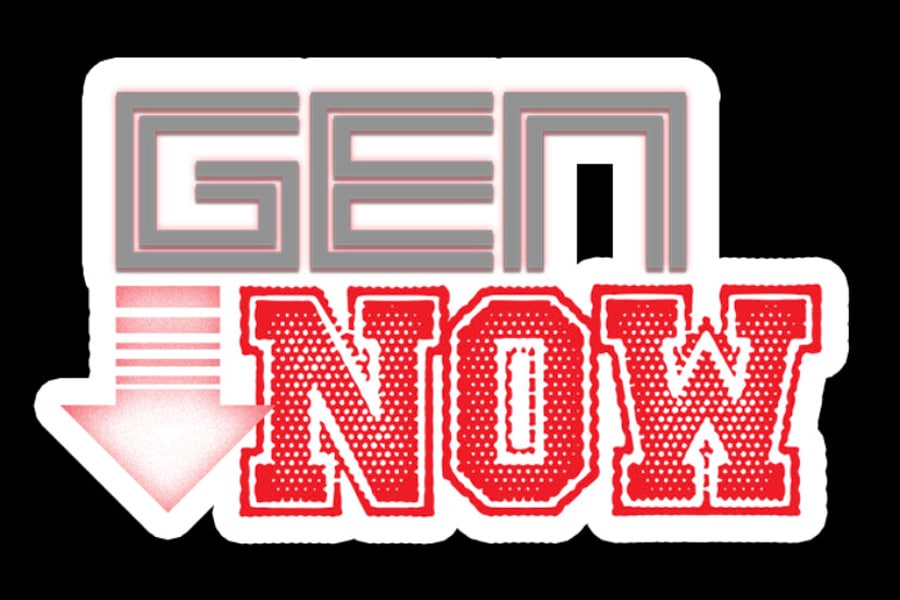
The Mutual Aid Collaborative is made up of 60 Black and Brown leaders and committed allies who live and work in the communities they serve on the South and West sides. They have raised over $86,000 to support several active projects, including Generation NOW. The Mutual Aid Collaborative met and collaboratively voted in May to provide Generation NOW with the funding to film another episode at the Foster Park District.
Generation NOW aims to provide young people with a setting to be open about their opinions, while also providing them with experience with different aspects of television production. Teens are invited to work on the project as writers, production members, or actors and are compensated for their work. On August 5th, the funds provided by the Mutual Aid Collaborative were used to pay 10 teenagers $250 each for their involvement in a day of filming. Funds were also used to provide them with meals and entertainment and also paid for a camera crew. Generation NOW aimed to provide the teens involved with a new opportunity to express themselves without judgment.
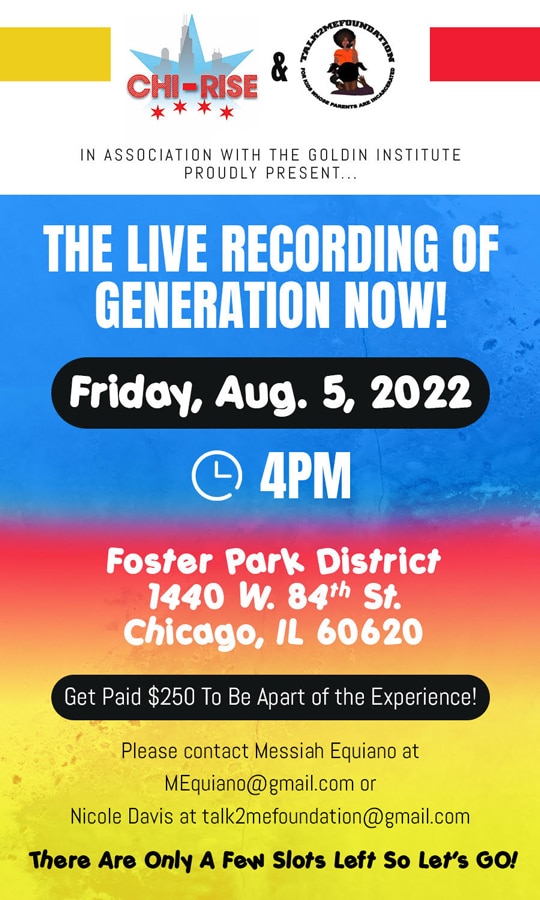
The young people were not only provided with food and time to get to know each other, but they were also told not to laugh at each other or dismiss opinions and were assured that the raw footage from the filming would not become publicly available.
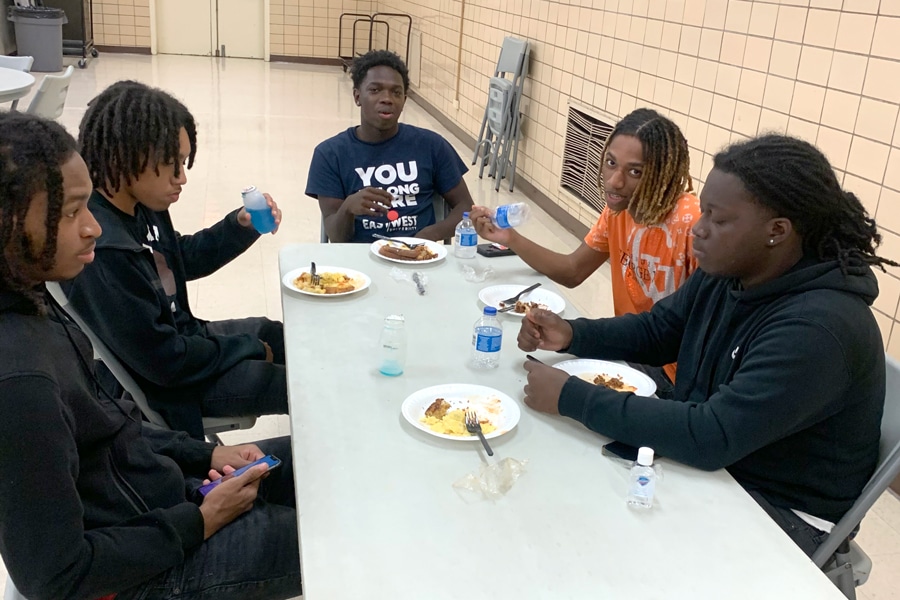
The filming of Generation NOW on August 5 was a collaborative effort between Peace Fellows. Alongside Messiah, Nicole Davis and the Talk to Me Foundation brought in actors and rehearsed together. As part of the filming, Nicole and her teens performed a skit where a woman accuses a man of stealing her purse, he denies stealing her purse, and she comes back with her brother to confront the accused man. At the end of the skit, someone approaches the woman and informs her that she left her purse in the bathroom and she apologizes. This scene was modeled after the experiences of the teens themselves, who gave input on how the scene might unfold.
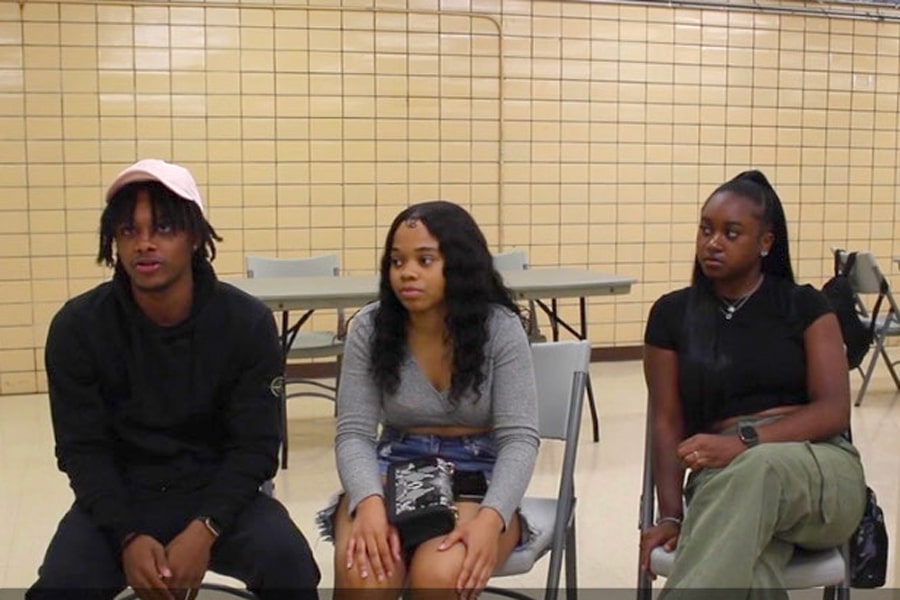
While Nicole led the rehearsal, the script of the conflict and resolution was developed by the teens. For instance, when asked what they would do if confronted about stealing, all of the young men at the filming responded that they would stand their ground during the confrontation and would not run away. The filming not only provided the teens involved with a platform to voice their beliefs without judgment, but also with a chance to enact their visions in a production and to work together collaboratively.
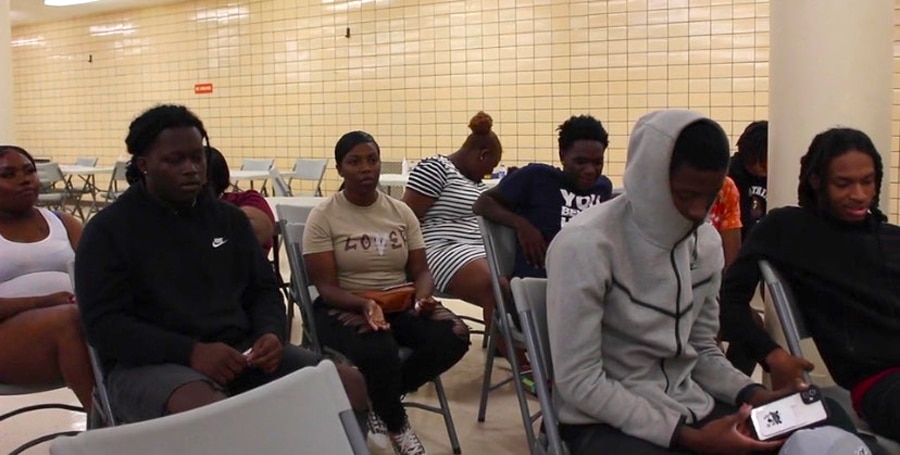
The response of the young people involved in Generation NOW has shown that the program is both therapeutic and empowering. Messiah spoke to the experience of the teens involved as they were provided with a platform to speak about topics like dating and conflict resolution: “Human beings hold onto so much in their hearts and their minds related to their experiences... Even if someone doesn’t express themself, just hearing another person make themselves available can make them feel better.” By continuing to provide this platform for teens and compensating them for their involvement, Messiah believes he can first them away from activities that might lead to violence:
[Generation NOW is about] getting a gun from someone’s hand and a camera into it. I’ve seen this in real life, I’ve seen people love it... you put a camera in his hand and he loves it. You’ve got to give them alternatives and have them get paid for it.”
Messiah’s organization, CHI-RISE, is looking for funding to continue to produce episodes of Generation NOW. They are also looking towards expanding the programs to different communities, and looking specifically at communities with higher risks of violence. Through community collaboration, they are hoping to help teenagers find work on the project during summer and winter recesses from school. Ultimately Messiah hopes to create a sustainable model for Generation NOW by getting members of the community involved and having them watch the show. Through creating content that gives back, Generation NOW aims to create safer and more connected communities.
Hands-On Peace: how youth leadership leads to peace
By Jamal Alkirnawi, 2018 Goldin Global Fellow, Rahat, Israel

"We all feel that the violence in Israeli society is increasing and threatening to get out of control. To prevent this grim scenario, it is not enough to deploy police forces and create deterrence. We must deal with the unrestrained functioning of the social networks that intensify the conflict in general and among the younger generation in particular."

The availability of social networks and electronic devices has created echo-chambers that drastically reduce the amount of information that contradicts and challenges our accepted perceptions. This significant drop in exposure to reliable and critical sources of information affects the youth specifically, resulting in herd behavior of acting without critical and adequate thoughts. This phenomenon can be explained by the growing sense of individualization among the post-1980 generations. These generations are the Y, Millennials, Z, and A generations, which we understand as Gen Y refers to those born between 1980 and 1985; Millennials were born between 1986 and 1995; Generation Z was born from 1996 until 2010; and the newest generation, generation alpha, are those born between 2010 and 2020s.
The culture of the internet interwoven with traditional beliefs oftentimes creates a contradiction between old and new values. Consequently, the tension we are observing in our Israeli communities in general, and particularly the Bedouin community, represents a period of transition from tradition to modernization. On one hand, our older generation Y group maintains their norms and practices; their traditions. On the other hand as the era of the internet permeates social networks, individualization has rapidly become a symbol of freedom and liberty. This, in turn, shapes the identity, language, and behavior of the members of Arab society. For instance, the usual norm in the Arab community is that families can make important decisions in determining the course of individuals’ lives. However, since the rise in internet usage the dynamic has become less and less reliant on the family and community. Everyone is occupied with his or her own virtual world and unable to create social contacts with outside environments, which is, in this case, their community.

In the recent escalation and the extreme cases of violence in the cities involved, we have seen the extreme consequences of this phenomenon. Teenagers got carried away by a wave of radicalization and instigation; they took to the streets to sow anarchy. Notable cases of this phenomenon are the events of “Operation Guardian of the Walls”, in which violent incidents and large-scale riots took place across Israel in May 2021. Hundreds were injured and three casualties were reported. This was overwhelming proof demonstrating the need to better educate teenage boys and girls to reduce the severe violence and incitement on digital networks.

To address the issue we initiated a new project in 2021. It is operated by the New Dawn Association in the Negev, a Bedouin-Jewish partnership located in the city of Rahat. So far, over 600 students in the Rahat area have been participating and benefiting from the series of educational sessions. We are currently looking into expanding the outreach to include the youth from nearby areas. The project promotes leadership programs and imparting skills to youth in the Bedouin society. Our long-term goal is to develop a generation of online activists who promote respectful democratic discourse and curb the violence and ranting therein.
To do this, we devote a lot of our resources to creating knowledge. We develop a wealth of expertise and tools that help the youth navigate the internet well. These include basic knowledge of principles of democracy, the difference between freedom of expression and incitement/hate speech, and how to create respectful discourses when engaging in online dialogues.
Our initiative of educating the Bedouin youth could not have been rolled out without the support from the partnerships, and foundations that sponsored in each and every capacity. We sincerely thank Eli Hurvitz and Foundation קרן שותפות for the generous and indispensable championship.
READ MORE AT
- https://www.jdn.co.il/video/1794825/
- https://www.israelhayom.co.il/magazine/hashavua/article/10194654
Swingset Activism: The Promise of Social Justice Education Inspired by Childhood
By David C. Metler, 2022 Goldin Global Fellow
“Swingset activism asks us to close our eyes and feel that exhilarating liberation you feel as a child on a swing soaring to new heights, perspective, and possibilities.”
Confucius once said that “we have two lives, and the second one begins when we realize we only have one.” I am convinced that social justice education has two awareness deepening lifecycle journeys. The first begins when you connect your personal experience to a systemic level and the second one begins when you realize social justice begins with childhood.
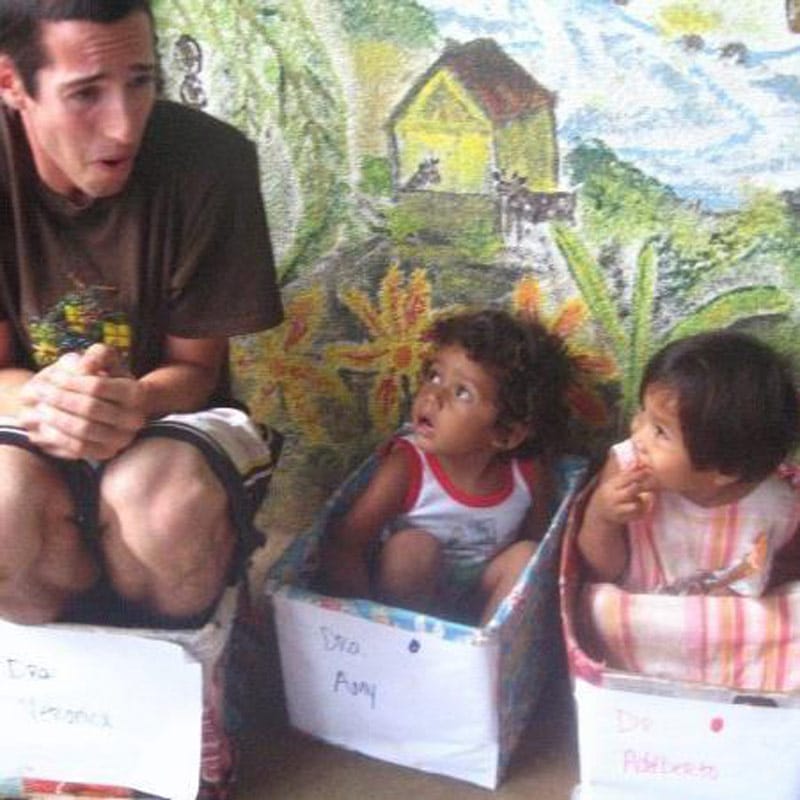
Integrating the Two Journeys
My first formal social justice education experience involved volunteering as a part of the Pangaea World Service Team in Nicaragua when I was a college student at the University of Michigan. It devastated me to learn about the leading role the US has played historically in keeping Nicaragua in poverty. I experienced what Bobbi Harro calls a “critical incident” which “creates enough cognitive dissonance that a change is initiated within the core of a person about what they believe about themselves”. Paulo Freire calls this “conscientizacao” – a transformative process from object to subject that lit my soul on fire for social justice.
Upon returning from this trip, I joined the social justice education University of Michigan’s Program on Intergroup Relations (IGR). Through social justice dialogues, I began to develop critical consciousness around identity, power, privilege, and oppression across personal, interpersonal, institutional, and systemic levels. An IGR mentor told me that there was a book, Parenting for Social Change by Teresa Graham Brett that would “blow my mind.” It completely did.
In bringing together parenting and social change, Teresa integrated her previous social justice education experience around identity and power (being a past co-director of IGR at UM) into her relationships with children. Teresa approached her relationships with children as a personal arena for practicing social justice which was integral to her pursuit of justice in the world. Her book helped me begin to see how a transformation of childhood could transform the world as I realized that there were profound lessons from the wisdom of children and childhood experiences that were invaluable for social justice education and activism.
For more than ten years I have worked with leading child and family activists from across the globe and since 2020, I have created the original concept of Swingset Activism which is currently being studied with a grounded theory approach through creative social justice education with the next generation of changemakers from across the globe. Swingset activism asks us to close our eyes and feel that exhilarating liberation you feel as a child on a swing soaring to new heights, perspective, and possibilities. Swingset Activism is a new type of activism inspired by childhood. There are many types of activism like environmental activism, relational activism, consumer activism, or design activism. Each offers a specific approach and focus lens to changemaking. Swingset Activism is activism generated by love that is integrative, relational, and imaginative. Swingset Activism brings together Ecological Systems Theory (Integrative), Relational Activism (Relational), and the Inner Child (Imaginative). It centers the significance of transforming childhood in activism as a strategy to maximize personal, social, and global transformation.
Swingset Activism brings forth a new level of awareness which catalyzed my search for my own authentic voice at the root of my passion for social justice. As I meditated on finding my inner child’s authentic voice for social justice, what came up for me is the earliest experience of being in the womb is lived experience of the profound interconnection and interdependence of human nature, and for the first few years of infancy there is no “other”. This is important to remember in pursuits of solidarity and partnership in social justice. It is our true nature. It is our original sense of inter-being that acknowledges that all of our liberation is bound together. Through the integration of these insights and practices the elasticity of my own mindset expanded of the whole world being one family and that children are, as Carol Stack would say, “all our kin”.
Understanding the wisdom of my inner child also brought back memories of having a clear, innate sense of right and wrong as a child. This recollection reminds me as an adult that the pursuit of social justice is not performative, but intuitive and relational.
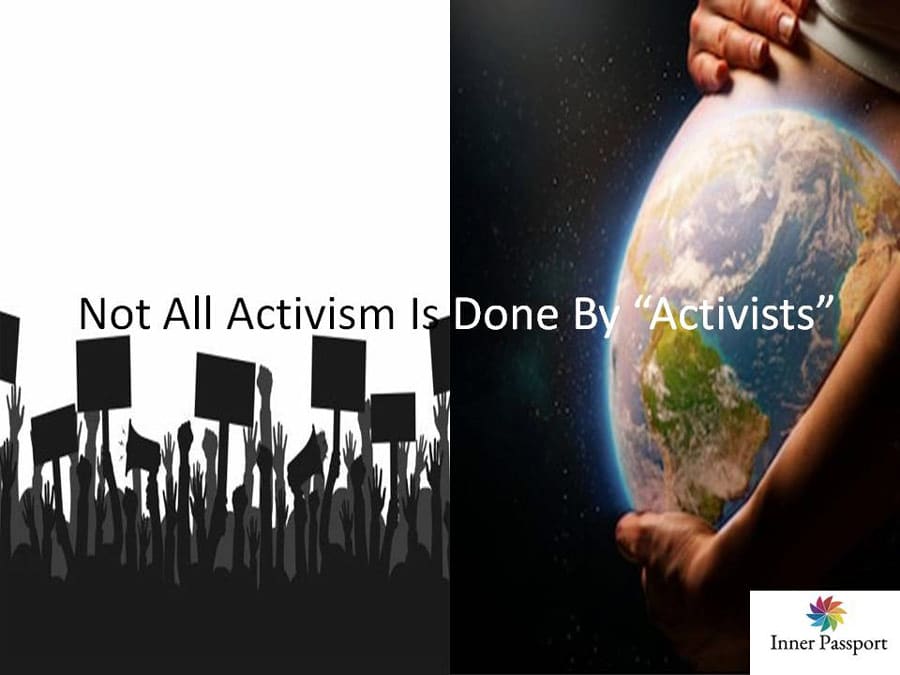
Activism as Relationship
Swingset Activism offers the insight that not all activism is done by “activists.” In their seminal academic article, “Relational Activism: Reimagining Women’s Environmental Work as Cultural Change” Sarah O’Shaugnessy and Emily Kennedy introduce the term “relational activism” for how we approach our personal and private lives that directly affect social change. Relational activism captures the behind-the-scenes, private sphere, community-building work of activism and highlights the importance of community, networks, and communication in contributing to long-term social change. Relational activism values public and private sphere actions equally while honoring the moments of social justice that happen within daily routines and in daily relations with others. For activism to be innovative and to generate a sustainable lifestyle, it needs to live within everyday moments of relationship, especially in building equal power relationships across social identity differences.
I believe that for activism to be integrated into a lifestyle it needs to relational and embrace elements of playfulness, joyfulness, loving-kindness, presence, creativity, and our capacity to re-imagine what’s possible. The process can then match the goal of social justice from integration of these valuable ways of being that children embody most regularly into activism. Audre Lorde says, “the master’s tools will never dismantle the master’s house” which calls upon our imagination and creativity in approaching social justice. I believe it acknowledges the wise contributions of children and childhood experiences in activism. It also serves as a reminder of the solidarity and sacrifice of children and youth literally being on the front lines of social justice movements throughout time, which is not credited since history is typically told by adults.
Intentionally approaching integrity in activism also requires looking critically at what I call the “activist paradox” exploring the ways in activists unconsciously recreate systems of oppression, linked to experiences of oppression in childhood within social justice efforts. Paying attention to these paradoxes will highlight the continual inner work adults need to do to heal their inner child. From reflecting on my childhood, I am able to begin a process of integration that allows me to link the change I wish to see in the world; in myself and my daily routine, ways of being, and relations with others. I have learned to view activism in a relational way that practices social justice in everyday moments, with change happening at the speed of trust, and inner and outer change being interdependent across levels.
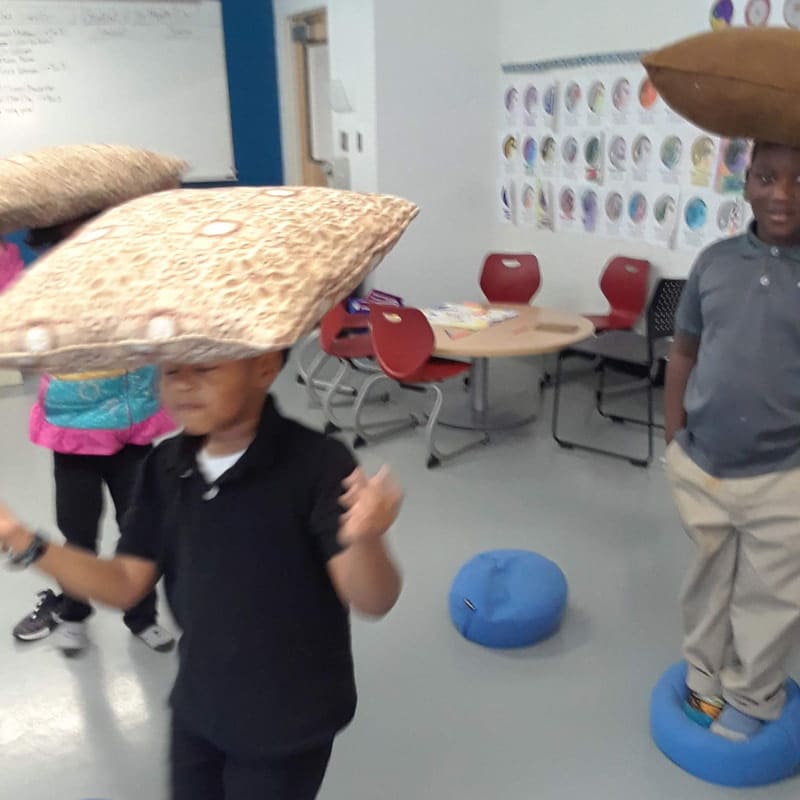
Imagining a Transformed World
As an activist, there is a desire to see clearly the roots of injustice and oppression so that efforts to create change actually transform the systems of oppression and not just the symptoms of oppression. It is known that the nature of oppression is non-hierarchical and intersectional but less known is how oppression is foundational in childhood. The wisdom of the science of relationships has revealed how our earliest relationships set a blueprint for relationships over the lifespan.
Since the oppression of children is the earliest, most normalized, and rationalized form of oppression; it provides the foundation for other forms of oppression because the first relationships in childhood root initial experiences with the common elements of oppression. These common elements of oppression are core to adultism, (the supremacy of adults over children), and underlie oppression in any form:
(1) a false notion of superiority across an identity difference becoming seen as an inherent belief that one identity group is superior to another and
(2) this belief being enforced as justification for the superior group to normalize its power and control over the other to maintain its superiority.
Adultism sets an invisible infrastructure for other socially constructed power-over divides across social identity to find deep hold, especially because children face the oppression of adultism with the least control and capacity to resist or language to make sense of the experience. Oppression then becomes internalized and normalized and the oppressed then become the oppressors, but oppression can be uprooted with the unlearning of adultism and the empowering of children, which is called childism, similar to feminism but for children.
Potentially, the most promising aspect of Swingset Activism, which focuses on social justice beginning with childhood, is that oppression is not only foundational in childhood it is notably the one oppression that all adults have common experience with – although there is difference in how adverse childhood was, everyone experiences adultism in some form during childhood. For example, despite increasing awareness of the commonality of Adverse Childhood Experiences, ACES, the overall experience of childhood involves a lack of control and domination over children by parents, teachers, and a larger institutional and societal culture of adultism. Because all adults were once children and still carry their childhoods within them, the convergence of adulthood and childhood can be comprehended in the mind and the profound interconnection of adult and inner child felt in body.
This shared experience presents an opportunity like no other for interest convergence, a concept that posits that there will only be social justice progress when it is perceived to be in the mutual interests of both the privileged and the oppressed. Unlearning adultism may provide the simplest convergence of mutual interest across a social identity power divide because it so plainly illuminates how deeply our liberation is literally bound up with one another and how adults and children are equal partners in the pursuit of social justice. Adults cannot be truly free until children are free, and until adults heal their inner child from the internalized oppression of their own childhood.
Swingset activism asks us to close our eyes and feel that exhilarating liberation you feel as a child on a swing soaring to new heights, perspective, and possibilities. As Teresa Graham Brett wisely reminded us, we can in full swing begin to “imagine a world where mistrust, power-over dynamics, domination, and oppression no longer exist because children have never experienced them.” We can begin to create a new story of childhood that creates lasting social justice and the transformation of what is possible.
If you would like to be a part of the founding of the Swingset Institute, please contact me at davemetler@gmail.com!
Sincerely,
David Charles Metler
2022 Goldin Global Fellow
Founder, Inner Passport
Global Fellows from Cameroon and the UK on a mission to help youth plan their future
By Mathias Ngong Njoya, Global Fellow from Cameroon
Personally, I have been unsuccessful in achieving new years’ resolutions! I also came to realize that many other young professionals are faced with a similar issue. So, I decided to come up with a biannual workshop that would help train and guide youth on professional development planning. We call it the Blueprint Workshop.

I teamed up with Dr. Gopal from the UK (a peer who I met during the 2021 Goldin Fellows Program) to join hands with my remote team members from Nigeria and Ghana in launching the biannual blueprint workshop. This two-day workshop took place from Jan 29 to 30th 2022 and brought together 30 youth from 15 countries in Africa and Asia. The second workshop of the year will be taking place in July 2022. The key objective for this first workshop was to invite young professionals to start the New Year with a clear set of achievable goals and provide them with goal-setting skills.
We had six speakers providing coaching on a range of topics such as the SWOT analysis (Strength, weakness, opportunities, and threats), effective goal setting, growth mindset, time management, overcoming procrastination, and development planning. We also shared templates that ga ve guidance to participants in implementing milestones which are key to achieving their goals. We have planned to pair all participants with accountability partners who will check in with them periodically. We are going to meet again with all the participants in the middle of the year to assess their progress together and offer additional support where required.
Participants shared positive feedback at the end of this two-day workshop with some requesting for the Blueprint workshop to be held quarterly so that they can track, learn and course-correct their plans in more regular periods.
"I used to think that SWOT is a tool only used by companies to devise strategies and assess markets. Through the workshop, I learned how to utilize SWOT for my own personal planning and strength assessment."
We hope to make the blueprint workshop available to more youth. It is useful to help them analyze factors outside their control while making plans. And tools such as time management can really help everyone become productive rather than simply being active. If you do not know how to prioritize, you will often not be productive.
Reflecting on the success of the workshop, I think it is crucial that I explore ways to partner with more Goldin Institute Fellows. Working with Dr. Gopal was great, and I now feel like I know him way better because we spent time planning and working together for the success of this workshop.
GATHER Alumnus Lo Ivan Castillon Shares Update from the Philippines

Greetings from Phillippines!
The Volunteers’ Initiatives in Bridging and Empowering Society (VIBES) is pleased to share with the Goldin Institute’s supporters about our activities in September 2019.
What were the highlights from your work this month?
VIBES through its Chairperson, Lo Ivan Castillon, participated in the Consultation Meeting as an organizational member of the Technical Working Group in the finalization of the Bangsamoro Transition Youth Priority Agenda (BTYPA) of the Bangsamoro Youth Commission (BYC) of the Bangsamoro Autonomous Region in Muslim Mindanao (BARMM) on 13-14 September 2019 in Kutawato Resto, Cotabato City. The objectives of the activity were to present and discuss the draft document and arrive at a final version which can be presented and discussed with the youth-serving ministries and development partners. BYC Executive Director Marjanie Macasalong, PhD, also a member of parliament, was in full support of the crafting of the BTYPA as a transition plan for 2019 to 2022. It was supported by UNICEF and UNFPA.

There were five priorities - health, education, peacebuilding and security, governance, and active citizenship. The peacebuilding and security priority ensures the promotion of human security, inclusive disengagement with reintegration programs, and the prevention of youths from association in armed groups, including participation in peacebuilding, conflict prevention and management initiatives, as well as safety efforts and development in the Bangsamoro region that contributes to national peace and security. It also integrated the youth, peace and security in all the strategies, objectives and programs considering the current and relevant issues confronting the youth in the region.
The draft BTYPA was presented to the ministries and offices of BARMM and to the development partners in the region on the 16th and 23rd of September 2019, respectively. Also, VIBES, as one of the members of the Technical Working Group of the Kutawato Messaging Hub, had a strategic planning on September 19-20, 2019 together with other CSOs and government agencies in Cotabato City and provinces of Maguindanao and North Cotabato. Hosted by Moroprenuer Inc. in the Bajunaid Building in Cotabato City, the activity was initiated and supported by the Equal Access International Philippines.

The Messaging Hub was also officially launched on the 20th of September with the goal of engaging grassroots communities on peacebuilding in the BARMM. It has the following outcomes:
- Increased community engagement in the normalization process and in the transition of BARMM
- Increased participation of youth and women in promoting peace
- Improved community socio-economic condition through social enterprise promotion
- Established positive and interactive community platform for information sharing and advocacy development
What activities were organized?
- In line with the celebration of National Peace Consciousness Month and International Day of Peace, VIBES conducted Basic Peace and Conflict Workshop for Children to 53 young leaders of Notre Dame Village Central Elementary School (NDVCES) on September 25, 2019 on the NDVCES grounds in Cotabato City. Several activities were facilitated where young leaders enjoyed and had fun during sharing and discussion sessions.
- September 5 October 5 is the celebration of Teachers’ Month. VIBES officially launched “Message for My Teacher” where the public were invited to share their messages to their teachers and take a selfie photo with them to be posted on their social media pages.
- VIBES is one with the world in striking for the climate. As part of our strike, we are challenging our fellow Vibers to take a video of themselves stating their commitment to save the environment and challenge 3 friends to do the same. This is an online platform campaign.

Thank you and more power!
Sincerely,
Lo Ivan Castillon
+VIBES Philippines
